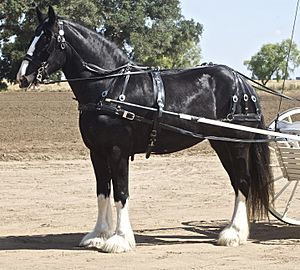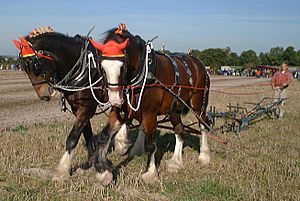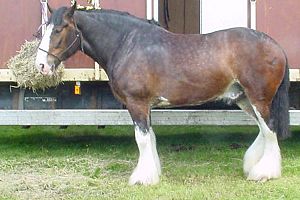Shire horse facts for kids

Shire pulling a carriage
|
|
| Conservation status | At risk (RBST, 2016) |
|---|---|
| Country of origin | United Kingdom |
| Distribution |
|
| Use | draught, show |
| Traits | |
| Weight |
|
| Height |
|
| Colour | bay, black, brown or grey |
| Distinguishing features |
|
| Breed standards | |
|
|
The Shire is a very large and strong horse breed from Britain. These horses are usually black, bay (reddish-brown), or grey. Shires are known for being very tall. They have even held world records for being the largest and tallest horses ever!
Shire horses are super strong and can pull huge weights. Long ago, they helped with farm work. They also pulled barges on canals, which were like water highways for moving goods. Shires were also used as cart-horses to transport things on roads. Today, some Shires still pull special carts for breweries, delivering beer. Others work in forests, are ridden, or help with advertising.
The Shire breed became official in the mid-1700s, but its history goes back much further. A special group called a breed society was started in 1876. They published the first book of Shire horse records in 1878. In the late 1800s and early 1900s, there were many Shires, and lots were sent to the United States.
However, as machines took over farm work and transport, fewer draft horses were needed. By the 1960s, the number of Shires dropped from over a million to just a few thousand. Luckily, people started to care more about the breed in the 1970s, and their numbers began to grow again. Still, the breed is considered "at risk" by a group called the Rare Breeds Survival Trust.
Outside of the United Kingdom, there are groups and record books for Shires in Australia, the United States, and Canada.
A Look Back in Time
Even though oxen (a type of cattle) did most farm work until the 1700s, horses strong enough for carts, plows, or carriages were sold in London as early as 1145.
The "English Great Horse" was very important during the time of Henry VIII. Back then, male horses shorter than 15 hands (a way to measure horse height) were not allowed to be kept. But as gunpowder weapons became common, heavy horses were no longer used in battles. Lighter, faster horses were preferred for cavalry. So, the big horses started to be used for pulling heavy loads instead.
In the 1500s, Dutch engineers came to England to drain wet lands called fens. They brought Friesian horses with them. These horses likely had a big impact on the development of what we now call the Shire breed.
From these medieval horses came an animal known as the "Old English Black Horse" in the 1600s. A farmer named Robert Bakewell helped improve this horse. He brought six mares (female horses) from the Netherlands or Flanders. This was important because most breeders focused on improving male horses. Two types of black horses developed: the Fen type, which was larger, and the Midlands type, which was more enduring.
The name "Shire horse" was first used in the mid-1600s. The "Packington Blind Horse" from Leicestershire is a very famous horse from this time. He is seen as the main founding father of the Shire breed. He was used for breeding from 1755 to 1770. In the 1800s, Shires were widely used to pull goods from docks through cities and the countryside. The rough roads meant people needed very large, strong horses.
In 1878, a group called the English Cart Horse Society was formed. It later changed its name to the Shire Horse Society in 1884. This group started keeping a record book of all Shire horses. The first book in 1878 listed 2,381 male horses and had records going back to 1770. Between 1901 and 1914, about 5,000 Shires were registered each year.
The first Shires arrived in the United States in 1853. Many more were imported in the 1880s. The American Shire Horse Association was created in 1885 to register and promote the breed there. Shires quickly became popular in the US. Almost 4,000 Shires were imported between 1900 and 1918.
Around the time of the Second World War, more machines were being used. Also, it became harder to buy food for livestock. This meant people needed and could keep fewer draft horses. Thousands of Shires were lost, and many large breeding farms closed. The breed reached its lowest point in the 1950s and 1960s. In 1955, fewer than 100 Shires were shown at the big annual British Spring Show.
In the 1970s, more people became interested in the breed, and it started to recover. Groups for Shire horses have been set up in the United States, Canada, the Netherlands, France, and Germany. In 1996, the first World Shire Horse Congress was held.
The Shire horse has changed its look over time. In the 1950s and 1960s, some Clydesdale horses were bred with Shires. This changed how the Shire looked. It especially changed the "feathering" (the long hair on their lower legs). It went from being coarse to the silky feathering we see on modern Shires.
At their peak, there were over a million Shires. But in the 1950s and 1960s, this number dropped to just a few thousand. In the United States, the Shire population fell a lot in the early 1900s. It kept going down in the 1940s and 1950s. Between 1950 and 1959, only 25 horses were registered in the US. However, numbers started to rise again. By 1985, 121 horses were registered in the US.
The National Shire Horse Spring Show happens every year. It is the biggest Shire show in Great Britain.
The Rare Breeds Survival Trust says the Shire is "at risk." This means there are likely fewer than 1,500 of them. In the United States, another group, the Livestock Conservancy, calls it "critical." The Equus Survival Trust says it is "vulnerable." These terms mean the breed needs help to survive.
What Makes a Shire Special?
Shire male horses (stallions) can be black, bay, brown, or grey. They should not be roan (a mix of white and colored hairs) or have too many white markings. Female horses (mares) and geldings (desexed males) can be black, bay, brown, grey, or roan. In the UK, stallions cannot be chestnut (a reddish-brown color), but this color is allowed by the US association.
An average adult male Shire horse is about 178 cm (70 inches) tall at the shoulders (called the withers). They must be at least 173 cm (68 inches) tall. Geldings should be at least 168 cm (66 inches) tall, and mares no less than 163 cm (64 inches). Geldings and stallions usually weigh between 850 and 1,100 kg (1,870 to 2,430 pounds).
A Shire's head is long and slender, with big eyes. Its neck is slightly curved and long. The shoulders are deep and wide, and the chest is broad. Their back is muscular and short, and their hindquarters are long and wide. They should not have too much "feathering" (long hair) on their lower legs. This hair should be fine, straight, and silky.
Shire horses are known for being calm and easy-going. They are also known to be at risk for a disease called chronic progressive lymphedema. This disease causes swelling, rough skin, and hardening of tissues in their lower legs. It is similar to a condition in humans.
The Shire horse can pull an amazing amount of weight. In 1924, at a British show, two Shires were thought to have pulled a starting load of 50 tonnes (about 110,000 pounds)! They pulled so much that it was more than the measuring machine could handle. At another show, the same pair pulled 18.5 tonnes (about 40,700 pounds) even on slippery ground.
The largest horse ever recorded was probably a Shire named Mammoth (also called Sampson). He was born in 1848. He stood 219 cm (86 inches) tall and was estimated to weigh 1,524 kg (3,360 pounds) at his heaviest.
Where Are Shires Used Today?
The Shire horse was originally the main breed used to pull carts. They delivered ale (a type of beer) from breweries to pubs. A few breweries in the UK still keep this tradition alive today. These include the Wadworth Brewery, Hook Norton Brewery, Samuel Smith Brewery, Robinsons Brewery, and Thwaites Brewery. Thwaites Brewery used Shires from the early 1800s to the 1920s. They brought them back in 1960, and Shire horses still make deliveries for them today. Some breweries, like Tetley's, have recently stopped using their Shire horse teams.
Today, Shire horses are also used for working in forests and for pleasure riding.
See also
 In Spanish: Shire (caballo) para niños
In Spanish: Shire (caballo) para niños




